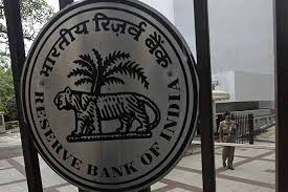 MUMBAI: Shedding its hawkish stance after 18 months, the Reserve Bank today sprang a surprise effecting a 0.25 per cent cut in interest rate that sent the markets soaring and raised expectations of lower EMIs for home and auto loans in the near future.
MUMBAI: Shedding its hawkish stance after 18 months, the Reserve Bank today sprang a surprise effecting a 0.25 per cent cut in interest rate that sent the markets soaring and raised expectations of lower EMIs for home and auto loans in the near future.
Though resisting nudges from the government and demands from the industry for long, the central bank decided to cut the benchmark lending rate or the repo rate a fortnight ahead of the scheduled monetary policy review on February 3, apparently on the back of a softening inflation.
The rate cut announcement was cheered by the stock markets with the BSE Sensex jumping over 600 points in early trade. The NSE index too moved up 176 points to trade above the 8,400-mark.
“It has been decided to?reduce the policy repo rate under the liquidity adjustment facility (LAF) by 25 basis points from 8.0 per cent to 7.75 per cent with immediate effect,” the Reserve Bank said in a statement.
The RBI had reduced the repo rate last time in May, 2013 when it cut the rate from 7.5 per cent to 7.25 per cent. Ever since, the rates have been going up and remained at 8 per cent since January 2014.
The rate follows decline in inflation as well as the commitment of the government to stick to the fiscal deficit target of 4.1 per cent of the GDP in the current financial year.
“These developments have provided headroom for a shift in the monetary policy stance,? the RBI said.
Analysts believe that today’s decision could pave the way for cutting retail lending rates that could see a reduction in the monthly payments on home, auto and other consumer loans.
Welcoming the RBI decision, SBI Chairperson Arundhati Bhattacharya said, ?We thus believe that this cut may be just the beginning of a rate easing cycle”, while Bank of Maharashtra Chairman S Munhot said many banks would now look at easing interest rates.
“We have already cut our base rate by 0.15 per cent last month in anticipation of rate reduction by RBI. Now we would look at some select sectors like MSMEs to reduce our spread,” he said.
While the retail inflation has slipped to 5 per cent in December, the Wholesale Price Index (WPI) inflation has remained near zero per cent in the same month.
Elaborating on the price situation, the RBI said, “Inflation outcomes have fallen significantly below the 8 per cent targeted by January 2015. On current policy settings, inflation is likely to be below 6 per cent by January 2016.”
Lower-than-expected inflation has been enabled by decline in prices of vegetables and fruits, cereals and the large fall in international commodity prices, particularly crude oil, it said, adding barring geo-political shocks, they are expected to remain low over the year.
The RBI, however, has decided to keep the cash reserve ratio (CRR), the portion of deposits which the banks are required to have in cash with the central bank, unchanged at 4.0 per cent.
Following reduction in the repo rate, the reverse repo rate has been adjusted to 6.75 per cent, and the marginal standing facility (MSF) rate and Bank Rate to 8.75 per cent.
The RBI in its fifth bi-monthly monetary policy statement in December had said that “if the current inflation momentum and changes in inflation expectations continue, and fiscal developments are encouraging, a change in the monetary policy stance is likely early next year, including outside the policy review cycle”.
In its public interactions, the RBI functionaries had committed to initiate the process of monetary easing as soon as data indicated that medium-term inflationary targets would be met, the statement said.
The December monetary policy had said that once the monetary policy stance shifts, subsequent actions would be consistent with this stance.
“Key to further easing is data that confirm continuing disinflationary pressures. Also critical would be sustained high quality fiscal consolidation as well as steps to overcome supply constraints and assure availability of key inputs such as power, land, minerals and infrastructure,? RBI said.
It said in the statement that there was a need to ensure that potential output rises above the projected pick-up in growth in coming quarters so as to contain inflation.
The RBI said that it would continue with daily variable rate repos and reverse repos to smoothen liquidity.
The central bank, it added, will ?provide liquidity under overnight repos at 0.25 per cent of bank-wise NDTL at the LAF repo rate and liquidity under 7-day and 14-day term repos of up to 0.75 per cent of NDTL of the banking system through auctions.” -PTI





